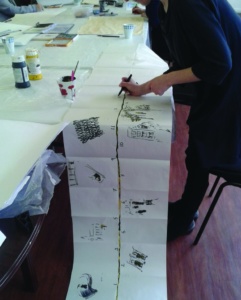I Get By With a Little Help from My…
Most all of my contemporaries are on some kind of medication regimen. Whether it’s for high blood pressure, cholesterol, bladder issues, hormone replacement, blood sugar — it seems like we’re all on something (and not in a fun way like the 70s). A history of less than optimal diet and poor exercise habits have led most of us, inexorably, to a state of better living through (doctor prescribed) chemistry.
Wouldn’t it be great to avoid, or at least reduce the medically prescribed pill popping?

Apparently in the U.K. and Australia, they’ve come up with a possible solution. Our friends across the pond and down under have come to the same conclusions as researchers here in the U.S. — that taking part in artmaking can have a positive effect on the emotional and physical well-being of older adults. The difference in the U.K. is that the medical establishment proactively incorporates this into the healthcare environment.
Of the various strategies, the most intriguing is “Arts on Prescription”. In this model a health care provider makes a referral to a funded arts program or teaching artist usually for people experiencing mental health problems or social isolation (a huge health issue in the U.S.). Funding is commonly provided through the National Health Service and a local arts council.
Research specific to Arts on Prescription programs is limited but here is a body of evidence that supports the notion that active involvement in creative activities can provide a wide range of benefits, including the promotion of well-being, quality of life and health, increased levels of empowerment, positive impacts on mental health and social inclusion for people with mental health difficulties.
For example The Stockport Arts on Prescription evaluation found that participation in creative activities raised self-esteem, provided a sense of purpose, helped people engage in social relationships and friendships and enhanced social skills and community integration.
We in the U.S. can only hope that in the future, Medicare will cover the cost of an art class that might reduce blood pressure, relieve isolation and combat depression. It would be a welcome change to hear a doctor say, “take two painting classes and call me in the morning”.

